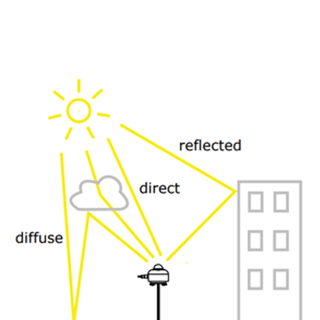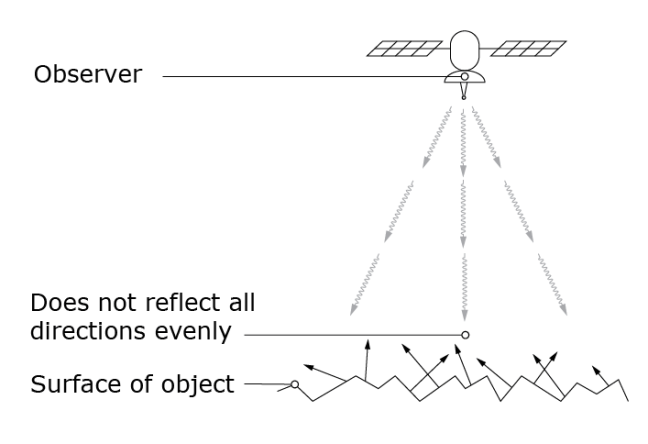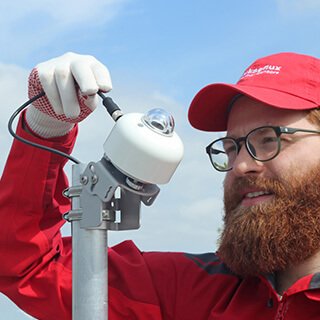Solar monitoring: using pyranometers in PV monitoring
Solar monitoring is a general term that refers to any data collection of solar energy using pyranometers. This data can include hours of sunlight or solar energy intensity measured in W/m2. PV monitoring is the comparison of the actual power output from the PV power plant to the expected output determined by solar monitoring. This real-time tracking allows us to identify potential problems and monitor the quality and efficiency of energy production.
High-quality solar monitoring systems are primarily used for large, commercial- or utility-scale PV power plants. A solar monitoring system ensures you yield maximum energy, reduce downtime, and keep your system in optimal condition. This article explains what pyranometers are, why monitoring sunlight can benefit you and how you can set up your PV performance monitoring system.
Pyranometers: the instrument for solar radiation measurements
Pyranometers are the main component of solar monitoring systems. They measure the sun’s energy received per unit area. When you have installed a solar panel or photovoltaic power plant, it is crucial to have a device that measures every watt of sunlight. An inaccurate solar radiation sensor will not measure every watt of sunlight. To avoid this, we use solar radiation sensors that are high-quality built, resulting in accurate measurements. Pyranometers are the answer to this problem. Hukseflux provides different pyranometer models of all accuracy classes, A, B and C. Class A is the most accurate, followed by classes B and C. Determining which class should be used can depend on the required accuracy or budget.
For a more detailed explanation of pyranometers, please read: What is a pyranometer?
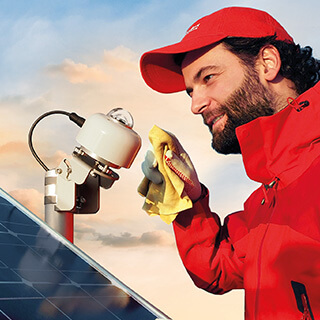
Why monitor sunlight?
If you have installed a pyranometer at your solar PV installation site, you might want to know why this is beneficial. Or if you still need to install a pyranometer, the following reasons might convince you. The three main captured data include:
- Electrical power output
- Energy performance
- Solar production energy
Comparing this data to the PV plant’s power output makes detecting issues easier. There could be new obstructions (trees, buildings, etc.) at your site or even panel inefficiencies. Also, validating panel performance against solar panel manufacturers’ claims becomes straightforward. Overall, having accurate pyranometers helps you calculate your solar system efficiency with real-time data. If you do not monitor the sunlight and suddenly see a drop in production energy from your solar panels, you cannot identify the problem causing this production energy drop. It could also be that there is no problem with your solar panels and that there is just less sunlight, but you would not know since you do not monitor sunlight.
Solar panel measure
How much energy is produced isn’t the only important factor for your solar panel system. Besides quantifying sunlight, pyranometers help understand panel angles, cleanliness, and weather conditions. Proper positioning and maintenance routines are essential to get accurate data.
Other factors to consider include:
- Spectral range: Make sure your pyranometer captures the entire relevant solar spectrum
- Durability: It should withstand environmental conditions, such as snow, dew, rain, and dust.
- Calibration: Make sure you calibrate your pyranometer within the given time span. Pyranometer calibration ensures consistent accuracy.
For a more detailed explanation of how to measure sunlight, please read the article: Measure sunlight: what instrument to use.

which mitigates dew and frost.
Next generation pyranometers
Earlier models of pyranometers decreased in measurement accuracy when covered by dew and frost. In recent years, Hukseflux has emphasised providing products with dew- and frost mitigation. Our latest pyranometers, such as the SR30-M2-D1, include heating. With the heating, dew and frost deposition gets suppressed. This also leads to less maintenance, which saves costs.
Introduction to PV monitoring
The primary purposes of PV monitoring include detecting and localising faults and comparing performance to design expectations. This last purpose means that a manufacturer promises you a particular energy production from your PV plant for specific circumstances. You can check if these promises are valid through monitoring using a pyranometer.
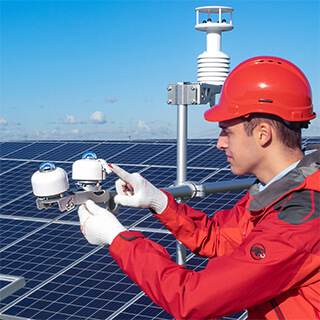
using pyranometers.
PV monitoring installation: The basic components
Now, we will provide you with the components of a simple solar monitoring system.
- Solar panels: These convert sunlight into electricity. Their efficiency depends on the manufacturer and the amount of sunlight they receive.
- Inverters: Devices that turn the solar panels' direct current (DC) into an alternating current (AC). This is important if you want to use this electricity for home or grid use.
- Solar radiation sensors: A pyranometer can measure global horizontal solar radiation. If you are interested in measuring albedo (read: What is albedo?) or longwave radiation, then an albedometer or net radiometer is useful. Solar radiation sensors capture the data on solar irradiance.
- Mounting systems: These are structures designed to hold solar radiation sensors in place. Using mounting systems, you can install pyranometers on the plane of the PV modules (Plane Of Array). This enhances accuracy in performance ratio calculations.
- Monitoring software: Both software for solar panels and solar radiation sensors are helpful. Monitoring software allows you to track how much energy your panels produce in real-time. You can then conclude how efficiently your solar panels operate by looking at the solar radiation sensor data. Such monitoring software is being provided by companies like Inaccess and meteocontrol.
A total PV performance monitoring system needs more than the previously mentioned components. Components such as battery storage with charge controllers if you consider an off-grid system. With the tools in place, you can establish a robust and efficient monitoring system that maximises energy production and longevity for the entire setup.
Conclusion
Solar monitoring is more than just tracking the sun; it's about optimising energy yield and ensuring PV systems deliver as promised. At the heart of this solar monitoring is the pyranometer. Recent advancements, like Hukseflux, have made these devices even more reliable and accurate in adverse weather conditions. By pairing these with the right software and setup, anyone with a solar installation can get real-time insights into their system's performance. Comparing the data from a pyranometer to the solar panel data, called PV performance monitoring, gives more insight into solar panel efficiency. It’s an intelligent investment, ensuring your solar panels work efficiently and live up to their potential.








